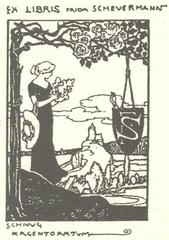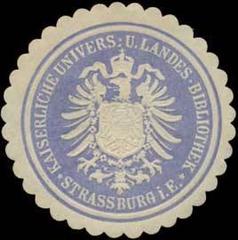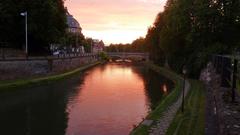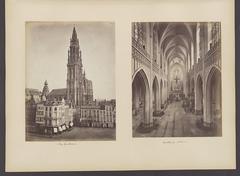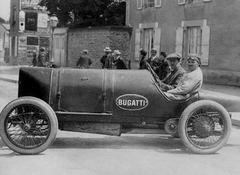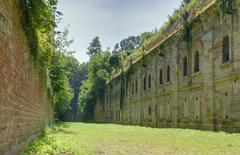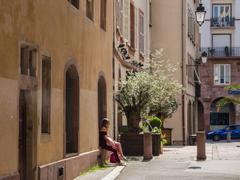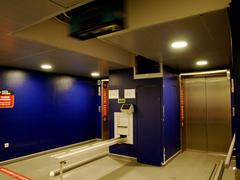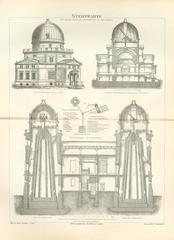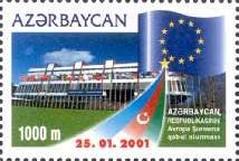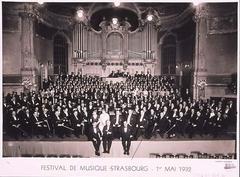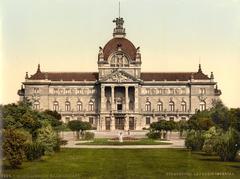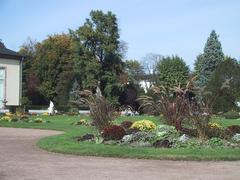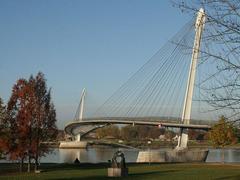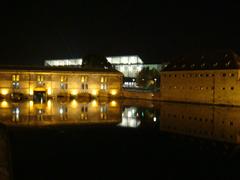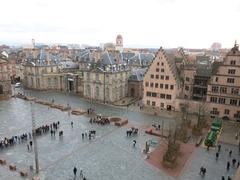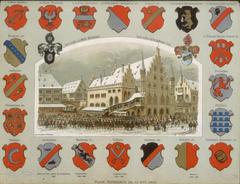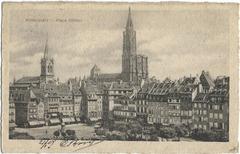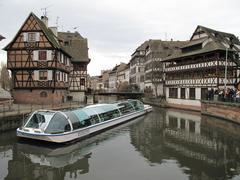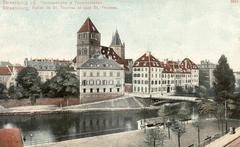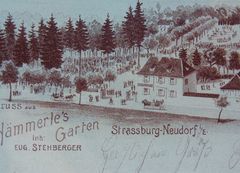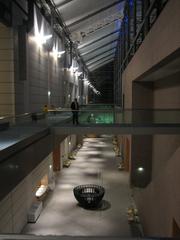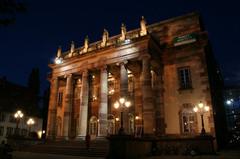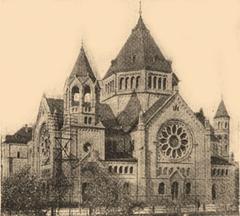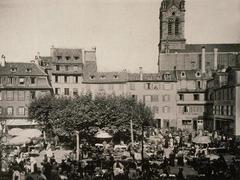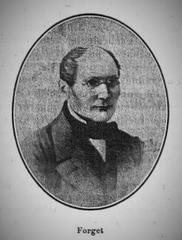
Aubette 1928 Visiting Hours, Tickets, and Guide to Strasbourg’s Historic Avant-Garde Landmark
Date: 03/07/2025
Introduction
Aubette 1928, located at the heart of Strasbourg’s Place Kléber, is one of Europe’s most significant examples of modernist interior design and a cultural icon bridging centuries of history. Originally constructed as part of a medieval monastic complex, the building evolved through neoclassical transformation and played various civic, military, and cultural roles before its radical reinvention in the 1920s. Its avant-garde interiors, conceived by Theo van Doesburg, Sophie Taeuber-Arp, and Hans Jean Arp, exemplify the De Stijl movement and the concept of the Gesamtkunstwerk—a “total work of art.” This guide details the site’s rich history, practical information on visiting hours and tickets, accessibility features, nearby attractions, and travel tips to ensure a rewarding visit to this Strasbourg landmark (The Charnel House; Visit Strasbourg; Musées Grand Est).
1. Historical Overview
Medieval Origins
Dating back to the 13th century, the Aubette was initially part of a large monastic complex, symbolizing Strasbourg’s role as a spiritual and economic hub in the Holy Roman Empire. After the demolition of most monastic buildings in 1552 during the Reformation, the remaining structures were repurposed for military use (The Charnel House).
Neoclassical Transformation
In 1764, the French architect Jacques-François Blondel transformed the site, unifying the remnants behind a neoclassical façade that still defines the northern edge of Place Kléber. This redesign established the architectural foundation for centuries to come.
Nineteenth and Early Twentieth Century
Throughout the 19th century, the Aubette served both military and civic purposes, eventually housing a café, concert hall, and museum. The building suffered significant damage during the Franco-Prussian War in 1870 and fell into neglect by the early 20th century.
2. The 1920s Avant-Garde Transformation
Visionary Collaboration
In 1926, a visionary partnership between Theo van Doesburg, Sophie Taeuber-Arp, and Hans Jean Arp resulted in the radical redesign of Aubette’s interiors. Their aim was to create a Gesamtkunstwerk—integrating painting, architecture, and design into a unified, immersive environment.
De Stijl Principles
The artists applied De Stijl’s principles: geometric abstraction, primary colors (red, blue, yellow), and the use of straight lines and right angles. The result was a series of bold, dynamic interiors that placed visitors “inside the painting”—a revolutionary concept in spatial experience (Visit Strasbourg; ArchDaily).
3. Notable Spaces
- Ciné-Dancing: Designed by van Doesburg, this space uses interlocking geometric planes and primary colors to create a kinetic, immersive setting for cinema and dance.
- Foyer-Bar: Conceived by Sophie Taeuber-Arp, the Foyer-Bar features playful, rhythmic motifs and a harmonious palette, blending art and social interaction.
- Salle des Fêtes (Events Hall): Hans Jean Arp’s sculptural reliefs add organic forms to the otherwise rectilinear space, creating a dynamic interplay of geometry and biomorphism.
4. Restoration and Preservation
By the late 20th century, most original interiors had been lost or concealed. A meticulous restoration campaign began in the 1980s, drawing on archival photographs and surviving fragments. The first floor reopened to the public in 2006, and Aubette 1928 is now classified as a Historic Monument, serving as a case study in the preservation of modernist heritage (Musées Grand Est; DailyArt Magazine).
5. Visitor Information
Visiting Hours
- Standard Opening: Wednesday to Saturday, 14:00–18:00.
- Closed: Sunday, Monday, and Tuesday.
- Note: Hours may vary for special events or holidays. Always check the official website before visiting (Wikihoraires).
Tickets
- Admission: Free for all visitors.
- Guided Tours: Available in multiple languages by prior booking; recommended for groups and those seeking in-depth context (Visit Strasbourg).
Accessibility
- Fully accessible for visitors with reduced mobility, with elevators and ramps. Contact the venue in advance for group accommodations or special requirements.
6. Travel Tips and Nearby Attractions
- Location: Place Kléber, central Strasbourg; easily reached via tram lines A, B, D (stop: Homme de Fer).
- Other Attractions: Strasbourg Cathedral, Petite France, Palais Rohan, Museum Œuvre Notre-Dame, and the Archaeological Museum are all within walking distance.
- Seasonal Visits: The area is especially festive during Christmas, with markets and decorations transforming Place Kléber (Museumspedia).
7. Events and Contemporary Use
Aubette 1928 is not only a preserved historic site but also an active cultural venue. It hosts exhibitions, concerts, performances, and workshops, continuing its legacy of artistic experimentation (67 Agenda Culturel; Strasbourg Pratique).
8. Frequently Asked Questions (FAQ)
Q: What are the current visiting hours?
A: Wednesday to Saturday, 14:00–18:00; closed Sunday to Tuesday (Wikihoraires).
Q: Is admission free?
A: Yes, entry is free for all visitors.
Q: Are guided tours available?
A: Yes, in several languages by advance booking.
Q: Is the site accessible for people with disabilities?
A: Yes, fully accessible with facilities for visitors with reduced mobility.
Q: What nearby attractions should I visit?
A: Strasbourg Cathedral, Petite France, Museum Œuvre Notre-Dame, Archaeological Museum, and the Christmas market at Place Kléber.
Q: How do I get there by public transport?
A: Take tram lines A, B, or D to Homme de Fer, then walk 5 minutes to Place Kléber.
9. Visuals and Media
Aubette 1928’s official website and Strasbourg tourism portals offer virtual tours and high-resolution images of the restored interiors. Alt text for images includes:
- “Interior view of Aubette 1928 Ciné-Dancing with geometric primary colors”
- “Sophie Taeuber-Arp designed Café-Bar at Aubette 1928 in Strasbourg”
- “Restored wall reliefs by Hans Jean Arp in Aubette 1928 Events Room”
10. Conclusion and Visitor Tips
Aubette 1928 is a living testament to the transformative power of modern art and design. Its meticulously restored interiors, free admission, and central location make it a must-visit among Strasbourg’s historical sites. For a richer experience, book a guided tour, and consider combining your visit with other nearby attractions. Use digital resources like the Audiala app for audio guides and event updates. Follow official channels to stay informed about exhibitions and cultural programming.
Whether you are an art lover, history enthusiast, or a traveler in search of inspiration, Aubette 1928 offers an immersive journey through the evolution of European modernism. Plan your visit today and discover why Aubette 1928 remains a cornerstone of Strasbourg’s cultural identity (Musées Strasbourg; ArchDaily; DailyArt Magazine).
Sources and Further Reading
- The Charnel House. The transformation of the Aubette in Strasbourg (1926-1928). (The Charnel House)
- Visit Strasbourg. Aubette 1928 Strasbourg. (Visit Strasbourg)
- Musées Grand Est. Les musées - L’Aubette 1928. (Musées Grand Est)
- Musées Strasbourg. Parcours Aubette. (Musées Strasbourg)
- ArchDaily. AD Classics: Café Aubette / Theo van Doesburg. (ArchDaily)
- DailyArt Magazine. Aubette 1928: A Neoplasticist Gesamtkunstwerk in Strasbourg. (DailyArt Magazine)
- Wikihoraires
- Museumspedia
- 67 Agenda Culturel
- Strasbourg Pratique
- Guide Tourisme France


